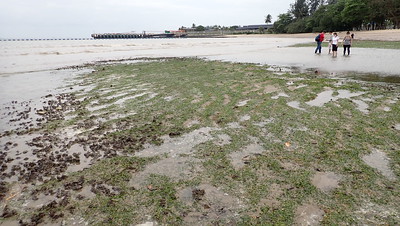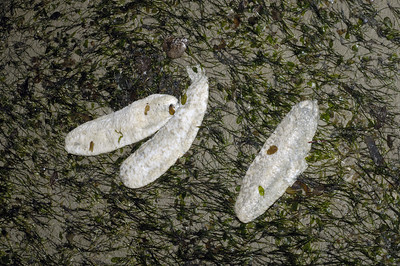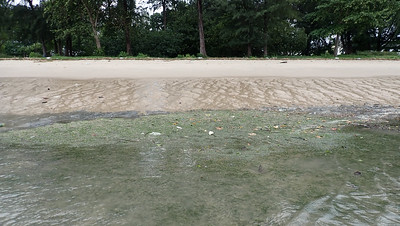 |
| Murky water suggests flood waters arriving from the Johor River. |
At Changi today, the water was very murky but we didn't see similar signs of mass death. Animals that usually succumb to freshwater are still present, and seagrasses are doing well. The impact of freshwater flooding on the shore, however, can be delayed. So it may be too early to be relieved just yet.
How does freshwater impact intertidal marine life?
The mass death at Chek Jawa in 2007 is believed to be due to non-stop rain in the weeks earlier. Intertidal marine life can tolerate wide fluctuations in salinity during normal daily tidal changes, and can even tolerate being exposed out of seawater in rain during the brief period of low tide.
 |
| Many dead animals at Chek Jawa Jan 2007 |
During massive flooding, freshwater can form a thick lighter layer floating on top of the denser seawater. This means the marine life is submerged in freshwater even at higher tides. Marine life cannot tolerate prolonged exposure to freshwater, and will die.
 |
| Dead sea cucumber on Chek Jawa, Jan 2007 |
Freshwater messes up marine life ability to control osmotic pressure. Carpet anemones bloat up like balloons and then burst and die. Sponges melt. Sea stars and sea cucumbers disintegrate.
 |
| Bloated and bleaching carpet anemones at Chek Jawa, Jan 2007 |
Impact of freshwater flooding can show up weeks after
Chek Jawa, Changi and our northern shores lies at the mouth of the enormous Johor River, which drains water from an area of Johor that is larger than the whole of Singapore! Even though it may not rain in Singapore, heavy and prolonged rain and flooding in Johor means massive amounts of freshwater will reach Chek Jawa and our nothern shores a few days and weeks later. Flooding is already reported in Southern Johor due to the recent non-stop rain.
 |
| From Sharmaine Toh (NUS), Thea Turkington (NEA) et al. December 2018. Subseasonal forecasting of major wet spells in the southern Malay Peninsula |
Freshwater death in 2019?
We did see some signs of death at Chek Jawa in the year end monsoon season of 2019/20 after prolonged rain and flooding in Johor. During our survey of Chek Jawa on 14 Dec 2019, we didn't see mass death, although we came across some small sea stars that appear to be dying.

Situation at Changi today
Today at Changi, I saw several Haddon's carpet anemones and they were all fine. Not bleaching, not bloating.
I saw many large healthy White sea urchins, much more on on our last survey in Aug 20. I already observed a reduced number of sea cucumbers on our last survey. Today, I saw much fewer Pink warty sea cucumbers and Thorny sea cucumbers. I also saw live Orange sea cucumbers. We also came across one medium sized healthy Biscuit sea star. We saw more kinds and numbers of sea stars on our last survey.Although there were many shells of dead horse mussels washed ashore, living animals are still abundant just below the low water mark. They still grow densely on the seaward side on the shore.
Other molluscs were also still plentiful. There were still many large Fan clams, as well as a lot of Window pane shells. I saw one Hammer oyster. There were many Spiral melongena and their egg capsules.
The situation of seagrasses among mussels is similar to our last survey in Aug 2020. There is not much seagrasses growing among the mussels, many patches of mussels were bare of seagrasses.
The areas near the low water mark is soft and silty and seagrasses are growing well here.
The seagrass situation seems similar to what I observed in Aug 2020 and Nov 2019. Nearer the high shore, there were dense growths of Spoon seagrass with small and large leaves, and Needle seagrass with narrow leaves. I only saw very few Fern seagrass today. Further away from the high shore, there were many patches of Needle seagrass with broad leaves, which I first observed in Feb 2019. I found the small patch of Smooth ribbon seagrass near the high shore, but did see any Noodle seagrass that I saw in Aug 2018.
I also had a closer look at the flotsam that washed up on the shore. In particular, looking for large amounts of dead seagrass washing up, which is an indication of mass seagrass death in deeper waters. I didn't see signs of this. The flotsam comprised mostly the usual mangrove leaves and saplings.
The situation of seagrasses among mussels is similar to our last survey in Aug 2020. There is not much seagrasses growing among the mussels, many patches of mussels were bare of seagrasses.
The areas near the low water mark is soft and silty and seagrasses are growing well here.
The seagrass situation seems similar to what I observed in Aug 2020 and Nov 2019. Nearer the high shore, there were dense growths of Spoon seagrass with small and large leaves, and Needle seagrass with narrow leaves. I only saw very few Fern seagrass today. Further away from the high shore, there were many patches of Needle seagrass with broad leaves, which I first observed in Feb 2019. I found the small patch of Smooth ribbon seagrass near the high shore, but did see any Noodle seagrass that I saw in Aug 2018.
I also had a closer look at the flotsam that washed up on the shore. In particular, looking for large amounts of dead seagrass washing up, which is an indication of mass seagrass death in deeper waters. I didn't see signs of this. The flotsam comprised mostly the usual mangrove leaves and saplings.
The impact of freshwater flooding on the shore, however, can be delayed. So it may be too early to be relieved just yet.
See Changi shores for yourself!
More details on Changi - an easy intertidal adventure for the family.
What is the future of Changi shores?
Changi shores are precious because they may be reclaimed in the 2013 landuse plan by the Ministry of National Development released in response to 2013 Population White Paper.
The blue outlined areas are "Possible Future Reclamation". The plans include a road link (black line) from the mainland jumping off at Punggol, crossing to Pulau Ubin through Chek Jawa to jump off to Pulau Tekong before circling back to the mainland on Changi East. Proposed reclamation (in yellow) will bury Pasir Ris shores, Pulau Sekudu and Chek Jawa as well as the Changi Beach shores from Carpark 6 to Carpark 7.
Others on this survey
Vincent Choo
More details on Changi - an easy intertidal adventure for the family.
What is the future of Changi shores?
Changi shores are precious because they may be reclaimed in the 2013 landuse plan by the Ministry of National Development released in response to 2013 Population White Paper.
The blue outlined areas are "Possible Future Reclamation". The plans include a road link (black line) from the mainland jumping off at Punggol, crossing to Pulau Ubin through Chek Jawa to jump off to Pulau Tekong before circling back to the mainland on Changi East. Proposed reclamation (in yellow) will bury Pasir Ris shores, Pulau Sekudu and Chek Jawa as well as the Changi Beach shores from Carpark 6 to Carpark 7.
Others on this survey
Vincent Choo
Vincent Choo surveyed Marina East on 15 Jan
Marcus Ng surveyed Changi at the mouth of Changi Creek










